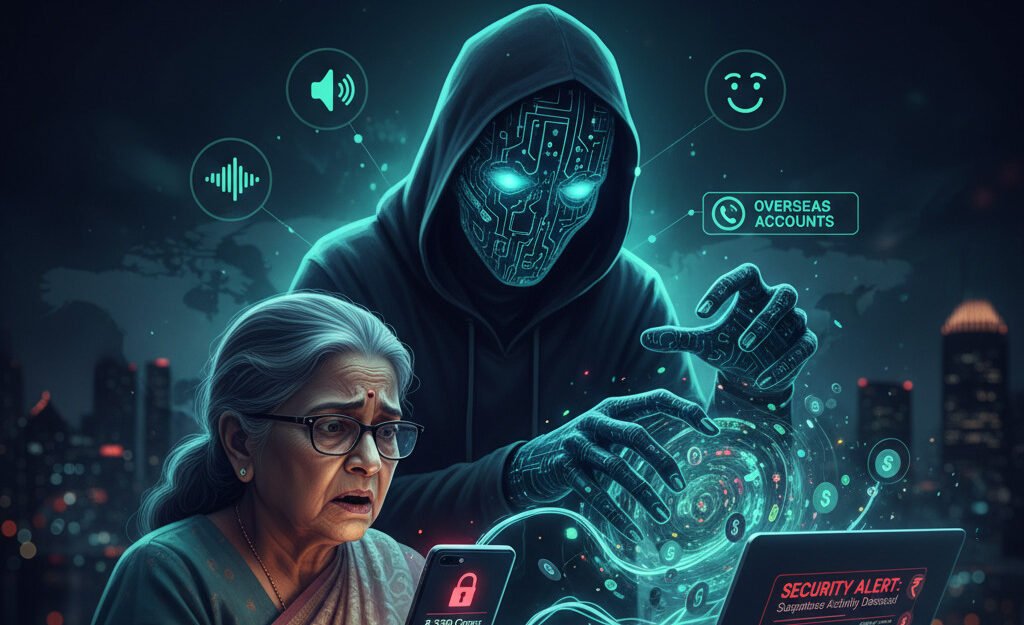A fast-growing cybercrime called the “Phantom Hacker” scam has become one of the most alarming global financial threats of the year.
According to investigative reports, criminals have stolen over ₹8,350 crore (US$1 billion) from elderly citizens’ bank accounts across the United States within just one year.
What makes this scam particularly dangerous is its deception: the fraudsters pretend to protect victims’ accounts while actually tricking them into transferring their own money.
What Exactly Is the ‘Phantom Hacker’ Scam?
The “Phantom Hacker” refers to a fake identity or organization that convinces people their bank account or device has been hacked.
Scammers impersonate tech support agents, bank officials, or government representatives, using fear and urgency to manipulate victims into cooperating.
The fraud typically unfolds in three well-planned phases:
Phase One: Creating Panic and Confusion
The scam begins when victims receive a fake security alert — via email, SMS, or computer pop-up — claiming suspicious activity in their account.
The message urges them to call a “support helpline” or click a verification link, drawing them directly into the scammer’s network.
Phase Two: Remote Access Trap
Once contact is made, scammers instruct victims to install remote-access software to “secure their system.”
In reality, this gives the criminals full control of the victim’s device.
They display fake warning screens or transaction windows, making it appear as if hackers have infiltrated the account — a completely staged illusion.
Phase Three: The Fake Government ‘Rescue’
In the final stage, another scammer poses as a Federal Reserve or government investigator.
They claim the victim’s funds must be moved temporarily to a “secure government account” for protection.
Out of fear and misplaced trust, victims transfer their money — which is immediately diverted into fraudulent overseas accounts.
AI Has Supercharged the Deception
The rise of Artificial Intelligence (AI) has made these scams dramatically more realistic and harder to detect.
According to cybersecurity experts:
- Voice Cloning: AI tools can replicate a person’s exact voice, making scam calls sound like a bank manager or family member.
- Caller ID Spoofing: Fraudsters manipulate caller IDs to show official bank or government numbers.
- Deepfake Documents: AI-generated emails, letters, and IDs appear completely authentic.
Recent studies report a 600% surge in AI-enabled cyber fraud in the past year alone.
Why Elderly Citizens Are the Prime Targets
- Most victims of the Phantom Hacker scam are above 60 years of age.
- They often have large retirement savings but limited digital literacy, making them ideal targets.
- Scammers exploit fear and urgency — psychological triggers that lead to impulsive decisions.
FCRF Launches CCLP Program to Train India’s Next Generation of Cyber Law Practitioners
Insights from Cybercrime Expert Prof. Triveni Singh
Former IPS officer and leading cybercrime specialist Prof. Triveni Singh explains that this scam is not just technological but psychological warfare.
“Phantom Hacker-type scams show that criminals are no longer hacking systems — they’re hacking human emotions and trust. Using AI, fraudsters can perfectly mimic real voices and identities, so victims unknowingly hand over their own information and funds.”
Prof. Singh stresses that awareness and behavioral caution are more effective than just relying on technology.
“No genuine bank, government body, or tech company will ever ask customers over a phone or email to transfer money or allow remote access,” he says.
“Always verify suspicious calls or links directly with official sources instead of reacting in panic.”
He further adds that digital literacy, timely reporting, and public vigilance are the strongest defenses against modern cyber threats.
Conclusion
The ‘Phantom Hacker’ scam exposes the dark side of digital progress — where innovation and deception evolve together.
AI has given criminals an invisible face and human-like precision, blurring the line between real and fake.
As Prof. Singh warns, the only lasting protection lies in awareness, skepticism, and proactive cybersecurity education — before trust itself becomes the next target.


